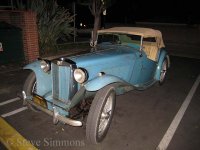Offline
In case you missed the New York Times article:
"WHEN it came time to freshen up Michelangelo’s “David” a few years ago, a spirited debate broke out over which restoration process would be most appropriate for the priceless artwork. Though the cleaning techniques under consideration varied widely in their aggressiveness, it is safe to assume that no conservator recommended sandblasting the 14-foot tall hunk of Carrara marble to remove the centuries of accumulated grime.
A similar reverence for original finishes and the patina of time is developing among collectors of classic cars, an appreciation for automobiles that have been well preserved through the years rather than restored to showroom (or better) condition. "
Here's the entire article:
https://www.nytimes.com/2007/08/19/automobiles/collectibles/19RESTO.html?pagewanted=1&_r=1
An interesting take on the need to "tear it apart and make it like new again".
Tom
"WHEN it came time to freshen up Michelangelo’s “David” a few years ago, a spirited debate broke out over which restoration process would be most appropriate for the priceless artwork. Though the cleaning techniques under consideration varied widely in their aggressiveness, it is safe to assume that no conservator recommended sandblasting the 14-foot tall hunk of Carrara marble to remove the centuries of accumulated grime.
A similar reverence for original finishes and the patina of time is developing among collectors of classic cars, an appreciation for automobiles that have been well preserved through the years rather than restored to showroom (or better) condition. "
Here's the entire article:
https://www.nytimes.com/2007/08/19/automobiles/collectibles/19RESTO.html?pagewanted=1&_r=1
An interesting take on the need to "tear it apart and make it like new again".
Tom

 Hi Guest!
Hi Guest!

 smilie in place of the real @
smilie in place of the real @
 Pretty Please - add it to our Events forum(s) and add to the calendar! >>
Pretty Please - add it to our Events forum(s) and add to the calendar! >> 


